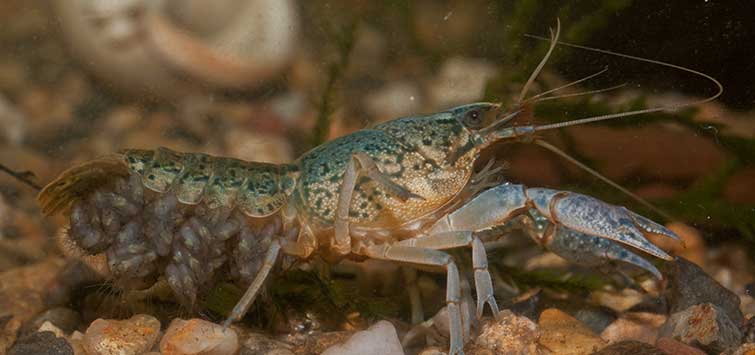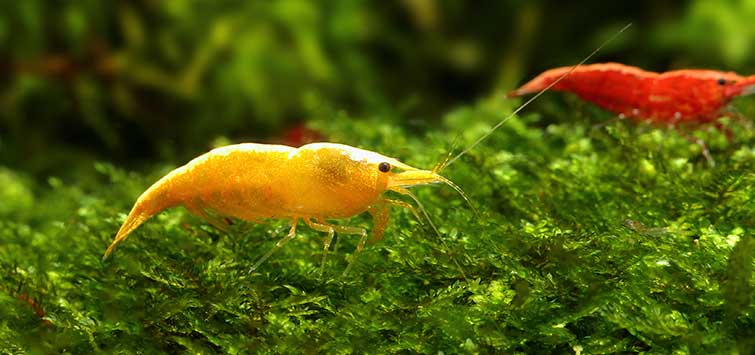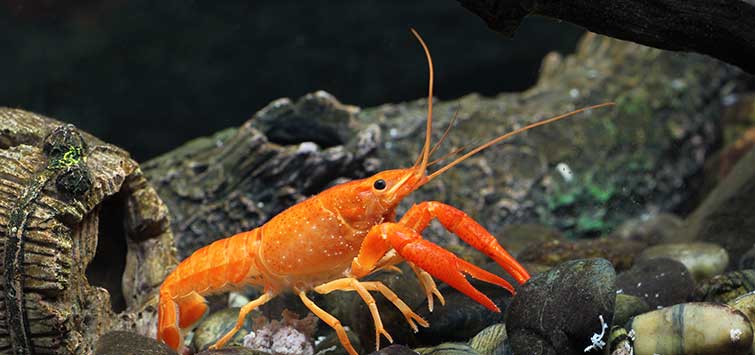Owning Clones
Author: Mark Robbins
Once the stuff of science fiction, cloning is not only happening in real-world laboratories, but also in home aquariums! One hobbyist relates his tale of keeping and multiplying the marbled crayfish, an all-female self-cloning species that one day just might help to feed the world.
When Cloning Becomes Reality
Until recently, the cloning of animals was simply the stuff of science fiction. Plant cloning has been a significant activity for some time (including by many producers of popular aquarium plants), and a few animals have now been cloned, to which some people raise ethical objections. But did you know that many organisms reproduce by cloning themselves? In fact, one is a new species that is only found in freshwater aquariums—it has no known natural origin!
A Marbled Clone
This aquatic clone is a crayfish that has no official scientific name yet, but it is known as a marmorkreb, or more commonly as the marbled crayfish. It was discovered in a German aquarium shop in the 1990s. Some crayfish enthusiasts speculate that it is an offshoot of a Procambarus species, but this has not been established as fact.
The gender of marbled crayfish is always female, and they do not need a partner to reproduce—they reproduce parthenogenetically. As their name implies, they feature an attractive brown marbled pattern, which is identical from individual to individual, and as they mature, they develop deep blue legs and even red and green colors in the claws. Their colors can also be affected by diet.
Because these unusual crayfish clone themselves, they are gaining popularity within the scientific community, particularly among scientists working on genetics and stem cell research. In the classroom they are used by biology teachers to demonstrate evolution (and cloning) in a current, real-world environment. Some aquarium hobbyists now use the marbled crayfish as a self-replicating source of feeders for carnivorous fishes of all sizes. Sport fishermen are raising colonies for use as bait, particularly for saltwater fishing, and it is even rumored that this species is being farmed by the Chinese government for use as a source of cheap food for humans!
Growth and Breeding
They grow very quickly to adulthood, usually around 3 to 5 inches (8 to 12 cm), at which point they can start to reproduce. From the time a baby hatches, it takes about 5 to 7 months for the crayfish to have babies of its own. Each of these female crayfish is capable of holding 400 to 1000 eggs each time, with incubation periods between 22 and 42 days. The younger adults have a smaller number of babies, with brood size increasing as they age. Apparently the mothers do not eat their young as most crayfish do, and they can occupy the same aquarium together with very little cannibalism. Still, the young ones sometimes overtake a sibling in a power play. Like other crayfish species, they grow by molting, or literally crawling out of their shell. Being efficient creatures, they will eat their discarded exoskeleton.
When a crayfish is brooding, it is said to be “berried,” as the strands of eggs resemble berries. There are now videos online showing the various stages of a marbled crayfish being berried (see the Resources section at the end of this article).
Wild Claims
An Internet search on the marbled crayfish will turn up a number of articles from the British press that feature frantic horror stories about this animal taking over ecosystems in Europe. While the marbled crayfish was discovered in Germany, it is considered an American animal. Hysterical, sensational hype found in British articles—in scientific journals and the tabloid press—also claim that this species carries a virus (or fungal plague) that can kill crayfish species exclusive to European rivers and lakes. However, biologists in the United States tend to downplay these stories, as no outbreak has actually been recorded in Europe or elsewhere. To date, marbled crayfish are legal to keep in the U.S. except in Nevada and Oregon, but this may change in the near future. Check with your state’s illegal species list to ensure that marbled crayfish are legal to own in your area before obtaining any.
Feeding
The diet of the marbled crayfish is mainly vegetarian, and it will eat most live plants found in aquariums, particularly Anacharis and Cabomba. It is my experience that marbled crayfish will not chase and eat aquarium fishes, unlike other crayfish species. They will, however, eat bloodworms and very finely chopped pieces of calf liver when mixed in with a vegetarian diet. Marmorkrebs also enjoy eating aquarium snails of all sizes and are very good to use for wiping out snail populations in overrun tanks. Interestingly, it is also possible to modify the color of this crayfish species with their diet. For example, feeding green-colored algae tablets over time will cause the entire animal to take on green colors. Likewise, feeding foods rich in the pigment astaxanthin,which is found in red algae such as Haematococcus pluvialis, will cause the crayfish to turn cherry red.
Required Filtration
Like any crayfish, they tend to be messy, and their water will eventually reflect the color of their diet if not properly filtered. Having tried a number of filtering setups, I have settled on a dual system—running an undergravel filter with a powerhead through a fine or sandy substrate, plus an external filter. The intake of any external filter should be covered with a sponge or filter media bag to prevent newborn crayfish from being sucked into the filter. This also creates a feeding station for the smaller crayfish.
Accommodations
Since the marbled crayfish is quite prolific, the size of the aquarium it lives in can be a concern for hobbyists interested in keeping it. Like other crayfish, the marbled crayfish likes to hide, a trait that allows keeping large numbers in relatively small places. PVC tubes, stacked in pyramids or other configurations, invite the crayfish to hide, feel safe, and develop eggs within. The addition of the PVC tubes effectively increases the livable area of their aquarium.
A Cooperative Species
This is a very good crayfish for a community tank, and they are also hardy, making them suitable for beginners to aquarium keeping. Most other species of crayfish will eat the fishes in an aquarium, but not the marbled crayfish, based on my experience. The marbled crayfish seems at home with most livebearers and tetras, as well as with most freshwater aquarium Caridina shrimp. However, all marbled crayfish babies are going to be a treat for fish, even small tetras, guppies, and others with small mouths. Cichlids are particularly fond of attacking and eating these crayfish at any size. Again, many people keep a separate tank to raise a colony of marbled crayfish to feed their carnivorous fishes, such as African cichlids, oscars, piranhas, arowanas, and marine carnivores like lionfish and groupers. Basically, if a fish likes to eat shrimp or krill, these crayfish are moving targets—targets that are very nutritious for fishes! There are also amphibians and reptile owners who feed their animals from marbled crayfish colonies.
Imposters
Some unscrupulous individuals and companies will sell similar species as marbled crayfish for very cheap prices. Be aware that many crayfish have similar colors and patterns. However, the fakes will chase and eat fishes and other aquarium residents, which the marbled crayfish does not do. And of course, the fakes cannot reproduce by cloning themselves. This crayfish is still considered rare, so it is wise to be wary of someone selling this species for very cheap prices.
A Food Source
There are forward-thinking world hunger groups who are beginning to think of the marbled crayfish to help feed starving people in many countries. For people who cannot eat shellfish for religious reasons, the colonies of marbled crayfish can be used to feed tilapia and other fishes that are edible for humans.
Resources
“A New Lab Animal without Sex.” Med Journal Watch: http://medjournalwatch.blogspot.com/2007/06/new-lab-animal-without-sex.html
“Life stages and reproductive components of the Marmorkrebs (marbled crayfish), the first parthenogenetic decapod crustacean.” Wiley InterScience: www3.interscience.wiley.com/cgi-bin/abstract/109087817/ABSTRACT
Marbled Crayfish: www.marbledcrayfish.com
Marbled Crayfish Channel. YouTube: www.youtube.com/user/MarbledCrayfish
Marmorkrebs.org, Advancing Research on Marbled Crayfish: http://marmorkrebs.org
“Ontogeny of the Marmorkrebs (marbled crayfish): a parthenogenetic crayfish with unknown origin and phylogenetic position.” Wiley InterScience: www3.interscience.wiley.com/cgi-bin/abstract/110456915/ABSTRACT?CRETRY=1&SRETRY=0
“The parthenogenetic Marmorkrebs (marbled crayfish) produces genetically uniform offspring.” PubMed: http://ncbi.nlm.nih.gov/pubmed/17541537 D
For further information, pictures, and more, please visit www.marbledcrayfish.com
See the full article on TFH Digital http://www.tfhdigital.com/tfh/200903/#pg75

.png?h=595&iar=0&w=2781&hash=5FD5E69473BCC22199FBFA2FB71B6033)



